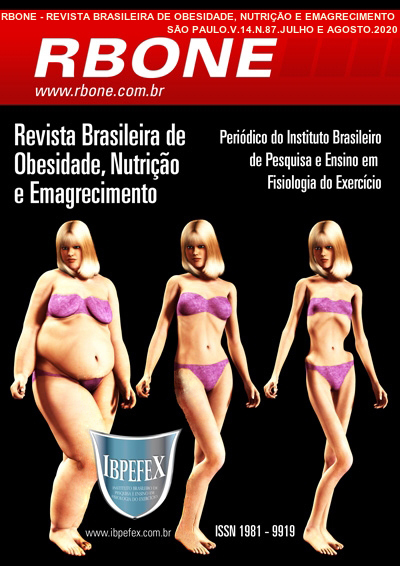Profile and knowledge of nutritionists regarding functional foods prescription
Abstract
Functional foods intake has been associated with the reduction of risk for chronic diseases and has been frequently included in dietary planning. The aim of this study was to evaluate the knowledge and prescription of functional foods by Brazilian nutritionists. Cross-sectional web-based survey comprised of four sections. First section collected general information, second questioned whether functional foods were prescribed and, if positive continued to following sections to indicate which functional foods and their main reference sources. Median and prevalence was used for the categories. Functional foods citations were reported as the number of times it was mentioned by the professional. Seventy seven nutritionists aged from 20 to 59 years responded. Among participants, 81,8% declared to prescribe functional foods. The majority of "non-prescribers" graduated less than five years ago. Foods mostly cited by the professionals were: oat, flaxseed and chia seeds (both source of soluble fibers), nuts, fish oil/omega-3. Functional foods are usually prescribed by nutritionists, and they demonstrated good knowledge on their indication for specific health conditions.
References
-ADA. American Diabetes Association. Lifestyle management. Diabetes Care. Vol. 40. Num. 1. p. 33-43. 2017.
-Anderson, J.W.; Baird, P.; Davis, R.H.; JuniorFerreri, S.; Knudtson, M.; Koraym, A.; Waters, V.; Williams, C.L. Health benefits of dietary fiber. Nutrition Reviews. Vol. 67. Num. 4. p. 188-205. 2009.
-Coates, A.M.; Hill, A.M.; Tan, S.Y. Nuts and Cardiovascular Disease Prevention. Current Atherosclerosis Reports. Vol. 20. Num. 10. p. 48. 2018.
-Crowe, K.M.; Francis, C. Academy of Nutrition and Dietetics. Position of the academy of nutrition and dietetics: functional foods. Journal of the Academy of Nutrition and Dietetics. Vol. 113. Num. 8. p. 1096-1103. 2013.
-Evans, C.E.; Greenwood, D.C.; Threapleton, D.E.; Cleghorn, C.L.; Nykjaer, C.; Woodhead, C.E.; Gale, C.P.; Burley, V.J. Effects of dietary fibre type on blood pressure: a systematic review and meta-analysis of randomized controlled trials of healthy individuals. Journal of Hypertension. Vol. 33. Num. 5. p. 897-911. 2015.
-Fedor, D.; Kelley, D.S. Prevention of insulin resistance by n-3 polyunsaturated fatty acids. Current Opinion in Clinical Nutrituion and Metabolic Care. Vol. 12. Num. 2. p. 138-146. 2005.
-Gul, K.; Singh, A.K.; Jabee, R. Nutraceuticals and Functional Foods: The Foods for the Future World. Critical Reviews in Food Science and Nutrition. Vol. 56. Num. 16. p. 2617-2627. 2016.
-Hauner, H.; Bechthold, A.; Boeing, H.; Brönstrup, A.; Buyken, A.; Leschik-Bonnet, E.; Linseisen, J.; Schulze, M.;Strohm, D.; Wolfram, G.; German Nutrition Society. Evidence-based guideline of the German Nutrition Society: carbohydrate intake and prevention of nutrition-related diseases. Annals of Nutrition and Metabolism. Vol. 60. Num. 1. p. 1-58. 2012.
-Kim, Y.; Keogh, J.B.; Clifton, P.M. Benefits of Nut Consumption on Insulin Resistance and Cardiovascular Risk Factors: Multiple Potential Mechanisms of Actions. Nutrients Vol. 9. Num. 11. p. E1271. 2017.
-Konstantinidi, M.; Koutelidakis, A.E. Functional Foods and Bioactive Compounds: A Review of Its Possible Role on Weight Management and Obesity's Metabolic Consequences. Medicines. Vol. 6. Num. 3. p. E94. 2019.
-Kushner, R.F.; Sorensen, K.W. Lifestyle medicine: the future of chronic disease management. Current Opinion in Endocrinology, Diabetes, and Obesity. Vol. 20. Num. 5. p. 389-395. 2013.
-Mozaffarian, D.; Bryson, C.L.; Lemaitre, R.N.; Burke, G.L.; Siscovick, D.S. Fish intake and risk of incident heart failure. Journal of the American College of Cardiology. Vol. 45. Num. 12. p. 2015-2021. 2005.
-Passi, S.J. Prevention of Non-communicable Diseases by Balanced Nutrition: Population-specific Effective Public Health Approaches in Developing Countries. Current Diabetes Reviews. Vol. 13. Num. 5. p. 461-476. 2017.
-Shang, A.; Cao, S.Y.; Xu, X.Y.; Gan, R.Y.; Tang, G.Y.; Corke, H.; Mavumengwana, V.; Li, H.B. Bioactive Compounds and Biological Functionsof Garlic (Allium sativum L.) Foods. Vol. 8. Num. 7. p. E246. 2019.
-Silveira, T.F.V.; Vianna, C.M.M.; Mosegui, G.B.G. Brazilian legislation for functional foods and the interface with the legislation for other food and medicine classes: contradictionsand omissions. Physis. Vol. 19. Num. 4. p. 1189-1202. 2009.
-SBC. Sociedade Brasileira de Cardiologia. VI Diretrizes brasileiras de hipertensão. Arquivos Brasileiros de Cardiologia. Vol. 95. Num. 1. p. 1-51. 2005.
-Villegas, R.; Takata, Y.; Murff, H.; Blot, W.J. Fish, omega-3 long chain fatty acids, and all-cause mortality in a low-income US population: results from the Southern Community Cohort Study. Nutrition, Metabolism, and Cardiovascular Diseases. Vol. 25. Num. 7. p. 651-658. 2015.
Copyright (c) 2020 Adriana Rosa Pereira Ferreira, Ana LuÃsa Kremer Faller

This work is licensed under a Creative Commons Attribution-NonCommercial 4.0 International License.
Authors who publish in this journal agree to the following terms:
- Authors retain the copyright and grant the journal the right of first publication, with work simultaneously licensed under the Creative Commons Attribution License BY-NC which allows the sharing of the work with acknowledgment of the authorship of the work and initial publication in this journal.
- Authors are authorized to enter into additional contracts separately for non-exclusive distribution of the version of the work published in this journal (eg, publishing in institutional repository or book chapter), with acknowledgment of authorship and initial publication in this journal.
- Authors are allowed and encouraged to post and distribute their work online (eg, in institutional repositories or on their personal page) at any point before or during the editorial process, as this can bring about productive change as well as increase impact and impact. citation of published work (See The Effect of Free Access).






